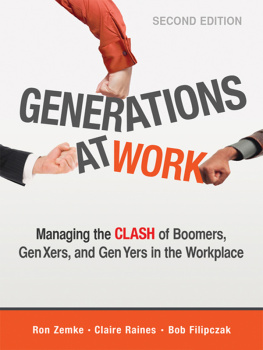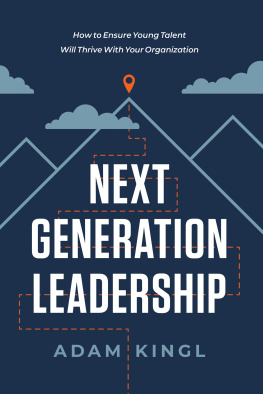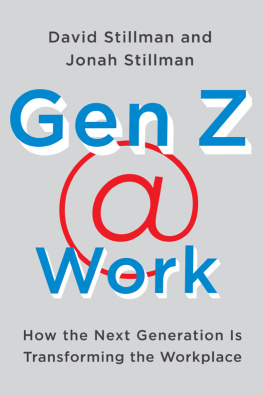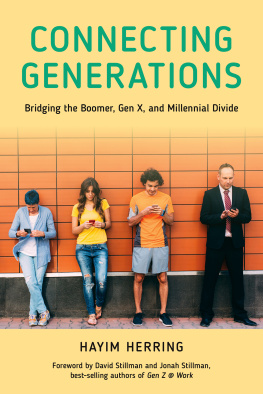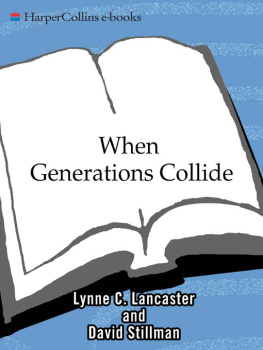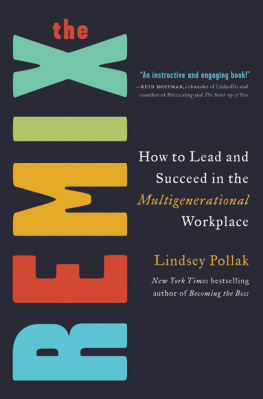
SECOND EDITION
Generations at Work
Bulk discounts available. For details visit:
www.amacombooks.org/go/specialsales
Or contact special sales:
Phone: 800-250-5308
E-mail:
View all the AMACOM titles at: www.amacombooks.org
American Management Association: www.amanet.org
This publication is designed to provide accurate and authoritative information in regard to the subject matter covered. It is sold with the understanding that the publisher is not engaged in rendering legal, accounting, or other professional service. If legal advice or other expert assistance is required, the services of a competent professional person should be sought.
Library of Congress Cataloging-in-Publication Data
Zemke, Ron.
Generations at work : managing the clash of boomers, Gen Xers, and Gen Yers in the workplace / Ron Zemke, Claire Raines, Bob Filipczak. 2nd ed.
p. cm.
Includes bibliographical references and index.
ISBN-13: 978-0-8144-3233-4
ISBN-10: 0-8144-3233-6
1. Diversity in the workplaceUnited States. 2. Age groupsUnited States. 3. Conflict of generationsUnited States. 4. Supervision of employees. I. Raines, Claire. II. Filipczak, Bob. III. Title.
HF5549.5.M5Z45 2013
658.30084dc23
2012040281
2013 Susan Zemke, Claire Raines, and Bob Filipczak.
All rights reserved.
Printed in the United States of America.
This publication may not be reproduced, stored in a retrieval system, or transmitted in whole or in part, in any form or by any means, electronic, mechanical, photocopying, recording, or otherwise, without the prior written permission of AMACOM, a division of American Management Association, 1601 Broadway, New York, NY 10019.
The scanning, uploading, or distribution of this book via the Internet or any other means without the express permission of the publisher is illegal and punishable by law. Please purchase only authorized electronic editions of this work and do not participate in or encourage piracy of copyrighted materials, electronically or otherwise. Your support of the authors rights is appreciated.
About AMA
American Management Association (www.amanet.org) is a world leader in talent development, advancing the skills of individuals to drive business success. Our mission is to support the goals of individuals and organizations through a complete range of products and services, including classroom and virtual seminars, webcasts, webinars, podcasts, conferences, corporate and government solutions, business books and research. AMAs approach to improving performance combines experiential learninglearning through doingwith opportunities for ongoing professional growth at every step of ones career journey.
Printing number
10 9 8 7 6 5 4 3 2 1
This second edition is dedicated to the memory of Ron Zemke
Introduction
The New Economic Reality and the Cross-Generational Workplace
I ts been more than ten years since the first edition of Generations at Work. The world has changed profoundly and so have our personal circumstances. In 2004, we lost Ron Zemke, one of our original coauthors. He was the driving force that led to the first book. Ron was a brilliant writer, an even more brilliant presenter, and a great mind and mentor. We still cant stand in front of an audience without thinking of him and, every time we get a laugh from the group, its because we are channeling Rons spirit. In updating this book, there are phrases and paragraphs and whole pages of the original that are pure Ron, and it hurts to revise them. Just the act of deleting the words seems sacrilegious. Fortunately Ron was nothing if not irreverent, so the idea that we would attach religious potency to his writing would have him chasing us from his office with heavy projectilesas we fled for the elevator on the eighteenth floor of Minneapolis Foshay Tower.
Suffice it to say, the world we live in has changed. In some ways, it seems as if the earth has shifted on its axis. We find ourselves near the endwe use that phrase with great hope and determinationof a dramatic economic decline that has affected the entire world economy. Recent years have seen a sharp increase in oil and food prices, a precipitous drop in international trade, and low consumer confidence. The European Union (EU) is stretched to its limits as it decides whether to bail out the failing economies of Greece and Spain. Growth has slowed in the formerly booming economies of China and India. In the United
The first edition of this book focused on generational issues in the United States where, in 2000, we were experiencing our ninth year of economic expansion. For nine years running, the United States had added more than two million workers a year to its payrolls. The unemployment rate hovered around four percent. So it makes sense that our first edition emphasized recruitment and retention, labor shortages, and meeting the demands of workers who knew they were sorely needed. Those workers knew that, if their current positions didnt suit them to a tee, they could get a job just across the street.
Today, employees from every generation are going back to the basics and lowering their workplace expectations. Elizabeth Milligan, a recent college graduate, describes the shift: I think the current economic crisis has changed things. I would have said a few years ago, Were really skilled. Were going to get jobs and were going to do something interesting. But we recognize that the economy is bad. If we can get a paycheck, were pretty lucky. Today were saying, We just need jobs.
The shifting sands of the economy are playing havoc with the generational mix in virtually every organization. The Boomersand even some members of the generation before themarent retiring as soon as everyone thought. As a result, Generation X is feeling as if it has been sentenced to an extended parole in middle management without much room for movement. And some Millennials will spend their early working years underemployed or even unemployed because the organizational pipes are clogged with more experienced Boomers and Xers.
Even though the current economic climate might make compromise on the part of employees and job seekers unavoidable, lets not be tempted to assume all those nagging differences among us will simply evaporate. While employees of all ages are surely less confident and emboldened than they were in 2000, history tells us that our tough economic times will be temporary. Job seekers might acknowledge that today they have to settle for less, and current employees might stay in their jobs a little longer, but that doesnt mean we will all perform at the highest levelsunless and until we create a workplace environment that respects and rewards workers of all ages. The cost to a business of replacing a disgruntled employee who is fortunate enough to find a greener pasture is approximately 2.5 times his or her annual salary. Now, more than ever, thats a cost few companies can afford.
In the first edition of Generations at Work, we made a case for a new crisis in the workplace that could be solved, or partially solved, by recognizing generational diversity. The work world was then at the beginning of an awakening about generational issues, and our primary objective was to convince readers that some common workplace complaintslack of respect and inability to work as a team, for examplecould, in many cases, be attributed to generational differences. We smiled to ourselves when you shared with us your ahh haaaa moments via email and after speeches and seminars. Awareness was raised. But in many cases, thats as far as it went. People got better at recognizing generational speed bumpsand even seeing how they affected work relationships and resultsbut they were often unsure how to navigate the speed bumps.
Next page
